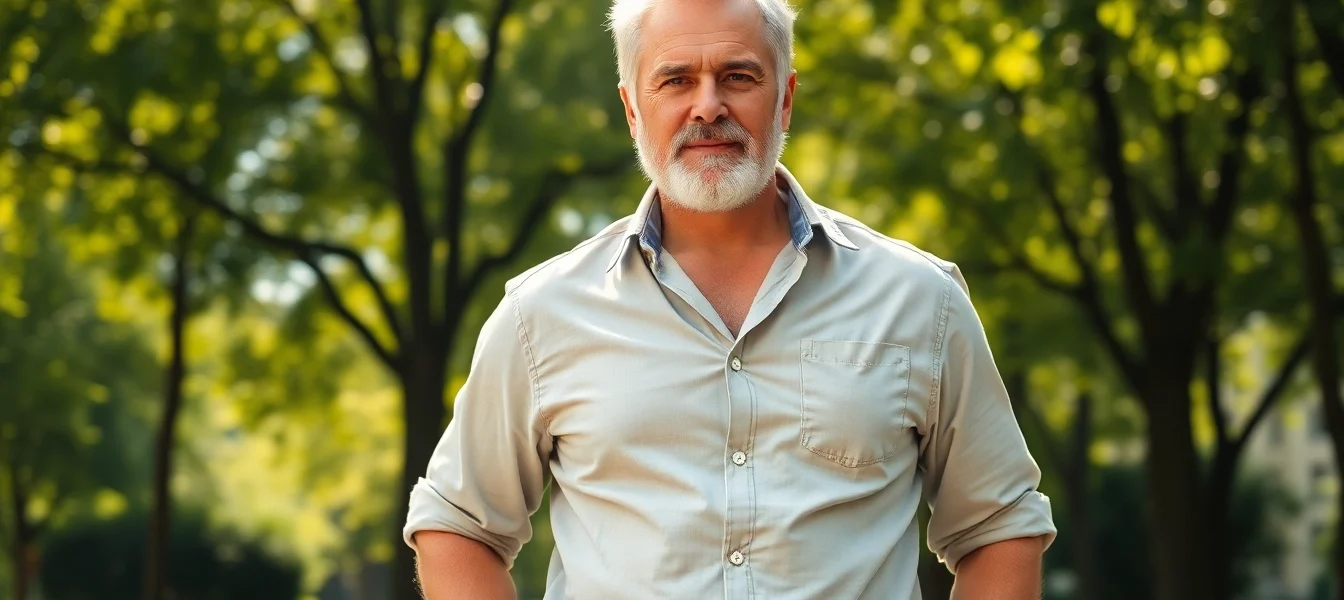The Rise of the DILF: Embracing the Modern Mature Man in Pop Culture and Internet Trends
Introduction to the Term DILF: Definition and Origins
The term dilf is a colloquial acronym that stands for “Dad/Daddy I’d Like to Fuck.” It is used to describe an older and typically mature man who exudes sex appeal and attractiveness, often in a way that combines charm, confidence, and a certain rugged or distinguished appearance. Contrary to what the acronym might imply, a man does not necessarily need to be a father to be called a dilf. Instead, the term has evolved into a broader cultural descriptor that celebrates mature masculinity, often infused with humor or admiration.
The origins of the term are closely linked to the rise of similar slang, such as MILF, which gained widespread popularity in the early 2000s. DILF gained traction shortly after, initially emerging within adult entertainment circles before making its way into mainstream media and internet culture. Its playful yet appreciative tone reflects societal shifts in how attractiveness and masculinity are perceived across generations.
While the term is often used humorously, it also carries a layer of genuine admiration for older men who maintain their appeal. The popularity of dilf is attributable to its versatility—used both affectionately and as a compliment—and its capacity to challenge stereotypes about aging and masculinity. Over time, the term has transcended its initial context, becoming a cultural phenomenon embraced by fans, media, and internet communities worldwide.
DILF in Popular Culture: Films, TV Shows, and Video Games
Daddy Halsin from Baldur’s Gate
In the realm of video games, Daddy Halsin from the popular role-playing game Baldur’s Gate III has become an iconic figure often affectionately called a dilf. Halsin is a druid and leader of the Emerald Grove, known for his protective nature, strength, and commanding presence. His character design emphasizes rugged masculinity, with features that many fans find appealing—broad shoulders, a commanding stance, and a nurturing yet powerful demeanor.
Fans of the game often refer to Halsin as a DILF because of his mature appearance combined with his caring personality, which exemplifies the archetype of a strong, dependable older man. His popularity illustrates how modern media characters can embody the qualities associated with the DILF label, blending attractiveness with wisdom and authority. Halsin’s character has sparked numerous fan arts, memes, and discussions, further cementing his status within gaming and online communities.
Fred Andrews in Riverdale
On television, Fred Andrews, the father of protagonist Archie Andrews in the Netflix series Riverdale, is frequently described by fans as a quintessential DILF. Portrayed by actor Luke Perry , Fred exudes a classic all-American masculinity—tough yet caring, responsible yet undeniably attractive. His mature charm and protective instincts towards his family have made him a fan-favorite and an ideal example of the DILF archetype in modern TV.
Fred Andrews’ character resonates with audiences because he embodies stability, strength, and a certain rugged appeal that is often associated with the DILF label. His role in the series highlights how the DILF archetype can be integrated into complex, multi-dimensional characters who balance attractiveness with depth and integrity, reinforcing the idea that maturity and masculinity are attractive qualities.
Rob’s Father in American Pie Presents: The Book of Love
The comedy film American Pie Presents: The Book of Love (2009) introduces a humorous take on the DILF concept through the character of Rob’s father. As part of the film’s comedic narrative, Rob’s dad is portrayed as a confident, attractive older man who is unapologetically charismatic—embodying many traits associated with the DILF archetype. The film plays with the idea that attractiveness and sexual appeal are not confined to younger men, emphasizing that confidence and charisma are ageless qualities.
This portrayal contributes to the humor and normalization of the DILF concept in popular culture, illustrating how mature men can be both humorous and genuinely attractive figures in media narratives. It also helps challenge stereotypes, showing that maturity does not diminish desirability but can enhance it.
Internet and Social Media Phenomena
DILFs of Disneyland Instagram Account
One of the most prominent internet phenomena celebrating the DILF archetype is the DILFs of Disneyland Instagram account. With over 300,000 followers, this social media page curates photos of fathers and older men enjoying family time at Disneyland, showcasing their charisma, style, and confidence. The account highlights that attractiveness is not limited to youth and that mature men can be just as captivating as younger counterparts.
This phenomenon has resonated with audiences worldwide, emphasizing a positive and playful narrative about aging and masculinity. It celebrates real-life DILFs—fathers, partners, and everyday men—who exude charm and confidence in candid moments, breaking stereotypes about aging and attractiveness. The account fosters a community that appreciates the appeal of mature masculinity in everyday settings, making it a defining part of modern internet culture around DILFs.
r/DILFs Reddit Community
Another influential online space is the r/DILFs subreddit, which gathers nearly 100,000 members. This NSFW community serves as a hub for sharing images, videos, and discussions centered around the DILF archetype. Members celebrate the attractiveness of older men, often posting photos of celebrities, fictional characters, and real-life individuals who embody the qualities associated with the DILF label.
What makes this community significant is its open acceptance and appreciation for mature masculinity, challenging societal standards that often prioritize youthfulness. It fosters an environment where confidence, charisma, and attractiveness in older men are normalized and celebrated. The subreddit also reflects a broader cultural shift towards embracing diverse representations of masculinity, especially as society becomes more accepting of aging and maturity as sources of appeal.
The Cultural Shift: From MILF to DILF — Changing Perceptions of Mature Male Attractiveness
The popularity of milf in the early 2000s marked a significant cultural moment where mature women’s sexuality gained visibility and admiration. However, as societal attitudes evolved, the focus expanded to encompass mature men as well, leading to the rise of the DILF archetype. This shift indicates a broader acceptance and celebration of aging masculinity, emphasizing that attractiveness is not solely reserved for youth.
Historically, media and advertising often marginalized older men, portraying them as less desirable or irrelevant. Today, however, there’s a noticeable shift towards recognizing the charm, strength, and appeal of mature men. This change is reflected in movies, television, social media, and internet communities where the DILF archetype is increasingly portrayed as confident, charismatic, and desirable.
This cultural transformation challenges traditional stereotypes that equate age with decline, instead highlighting qualities such as wisdom, experience, and confidence as attractive traits. The rise of the DILF phenomenon signifies a broader societal move towards inclusivity and appreciation for diverse representations of masculinity across age groups.
Why the DILF Archetype Appeals Today: Traits and Qualities
Physical Attractiveness and Style
At the core of the DILF archetype is physical appeal. Mature men who are considered DILFs often possess a combination of rugged features, a fit physique, and confident grooming. They tend to exude a sense of style that blends sophistication with practicality, often sporting well-fitted clothing, grooming that emphasizes masculinity, and a confident demeanor that draws attention.
Confidence and Charisma
One of the most defining traits of a DILF is confidence. This quality is often more attractive than physical features alone. Mature men who carry themselves with self-assuredness, speak with authority, and exhibit charisma naturally draw admiration. This confidence often stems from life experience, emotional maturity, and a sense of self-awareness that enhances their appeal.
Strength and Protector Instincts
Many fans associate DILFs with qualities like strength, dependability, and protective instincts. These traits evoke a sense of safety and security, making the archetype especially appealing in romantic or sexual contexts. The combination of physical strength and emotional maturity creates a compelling image of a man who is both capable and caring.
Humor and Approachability
Humor, warmth, and approachability also contribute to the DILF appeal. Men who can balance masculinity with kindness and humor are often viewed as more attractive. This combination makes them relatable and personable, further enhancing their desirability across various social settings.
Authenticity and Confidence in Aging
Finally, authenticity plays a crucial role. Modern DILFs often embrace their age, demonstrating confidence in their appearance and personality. This authenticity resonates with audiences, reinforcing the idea that attractiveness and charisma are timeless and accessible to all men, regardless of age.
The Future of DILF in Media and Popular Culture
As societal perceptions continue to evolve, the DILF archetype is poised to become even more prominent in media and popular culture. Future portrayals are likely to feature more nuanced and diverse representations of mature men, emphasizing qualities such as emotional depth, intelligence, and authenticity alongside physical attractiveness.
Entertainment industries are increasingly recognizing the value of mature characters who defy ageist stereotypes. Expect to see more films, TV shows, and digital content celebrating the charisma, confidence, and complexity of modern DILFs. Additionally, internet communities and social media will continue to play a vital role in shaping and normalizing the positive perception of mature masculinity.
This trajectory suggests a future where the DILF archetype is not only celebrated but integrated into mainstream narratives that highlight the richness of aging and the enduring appeal of confidence and charisma in men.
Conclusion: Celebrating the Charisma and Confidence of the Modern DILF / The Rise of the DILF: Embracing the Modern Mature Man in Pop Culture and Internet Trends
The dilf phenomenon encapsulates a broader cultural appreciation for mature masculinity, confidence, and charisma. From its origins as a playful slang term to its widespread presence in films, television, internet communities, and social media, the DILF archetype reflects a shifting perception of attractiveness that values experience, strength, and authenticity.
Whether portrayed as a rugged protector, a charismatic leader, or a charming everyday dad, modern DILFs challenge stereotypes about aging and attractiveness. They embody traits that resonate with contemporary audiences—confidence, humor, style, and genuine charisma—making them some of the most compelling figures in pop culture today.
As society continues to embrace diversity in representation and redefine masculinity, the rise of the DILF signifies a celebration of the modern mature man—one who exudes confidence and charm at any age. This cultural shift not only enriches media narratives but also empowers men to embrace their aging process with pride and authenticity.
In conclusion, the DILF archetype is more than just a humorous label; it is a testament to changing societal values and a celebration of the timeless appeal of confidence, charisma, and charisma in men. As the trend grows, expect to see even more nuanced and inspiring portrayals of mature masculinity, further cementing the DILF as a vital and celebrated part of modern culture.

